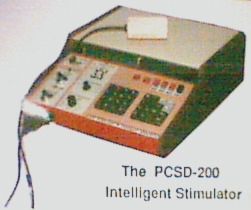Products & Services
|
Cardio Stimulator
The Model PCSD-200 microprocessor-based Programmable Cardio-Stimulator is a portable, line-powered, programmable pulse generator designed for use during cardiac electrophysiolgical studies. With PCSD-200 we are introducing the new concept of using an "ALGORITHM" in the operation of a cardio-stimulator. Up to 100 algorithms (stimuli sequences) can be stored in non-biolative memory. The algorithm concept allows for complex stimuli sequences to be devised in pre-operation (leisure) time and recalled instantly during a study. It’s as simple as pushing a button. For example, we wish to enter algorithm to define a pacing sequence which delivers 10 times four 500 mS pulses followed, a single premature 300 mS and a RESET (100 mS). The premature stimuli will decrement by 10 mS after each sequence. So the pulse sequence would look like: The alorithm will be: 10( 4(S(500)) S(300-10) R(1000)) A two-line, backlighted alphanumeric LCD display provides useful information during programming and study. The top line displays a parameter and algorithm editing window. The bottom line handles current cardiological parameters such as heart rate (ppm) or RR-interval (millisecond). Entry of data is through two keypads, one for numeric entry, the other for the algorithm functions and editing. Editing functions provide included character deletion and insertion and cursor positioning on the display. The PCSD-200 delivers high rate stimuli at a rate of up to 840 pulses per minute for emergency stimulation. The duration and current of an output pulse are continuously adjustable; duration: up to 19.8 mS with .1 mS increments, current: over a range of .4 to 25mA. A "time lock" control provides enhanced immunity to false trigering (sense) by detecting abnormaly high P- or T- waves.A recorder output control activates (normally open) an external recorder prior to stimulation and deactivates it after the stiumlation procedure, these delay times are user programmable. Internal circuitry of the PCSD-200 is isolated from the power line by a "SWITCHER MODE" power supply which provides 15 MegOhm minimum at 1,500 VAC. Two additional DC-DC converters which deliver a power to the input and output circuitry, provide more than 100 MegOhm isolation. Signals (from input and stimuli) pass through optical-coupled circuitries. These precautions provide maximum isolation between a patient and the power line.
For further information: Contact Us
|





 PCSD-200 Intelligent Stimulator
PCSD-200 Intelligent Stimulator